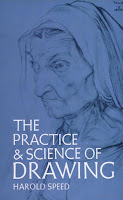 On the GJ Book Club, we're looking at Chapter 16: "Rhythm/Proportion" in Harold Speed's 1917 classic The Practice and Science of Drawing. The following numbered paragraphs cite key points in boldface. If you would like to respond to a specific image or point, please precede your comment by the corresponding number.
On the GJ Book Club, we're looking at Chapter 16: "Rhythm/Proportion" in Harold Speed's 1917 classic The Practice and Science of Drawing. The following numbered paragraphs cite key points in boldface. If you would like to respond to a specific image or point, please precede your comment by the corresponding number.Speed begins by introducing the idea that mathematical proportions may lie behind the design principles of older artists. He says:
1. There appears to be no doubt that the ancient sculptors used some such system.
Speed doesn't mention which system, or which proportions, whether phi, pi, square root of 2, Vitruvian or what? I, for one, am skeptical, and would want to see proof beyond the superimposed diagrams; I'd need to see actual texts from the artists themselves that specifically discuss the question of which system they supposedly used. There's more in my series "Mythbusting the Golden Mean." Speed himself says that art probably shouldn't be reduced to a mathematical formula. Then he asks a key question:
2. The question we are interested to ask here is: are there particular sentiments connected with the different relations of quantities, their proportions, as we found there were in connection with different arrangements of lines and masses? Have abstract proportions any significance in art, as we found abstract line and mass arrangements had?
Speed answers his question in a simple way that makes sense. In his words: "unity makes for sublimity, while variety makes for the expression of life." Here I don't think he means "sublimity" from the point of view of Edmund Burke's concept of the sublime as apocalyptic or terrifying, but rather more as calmly reverential.
3. Nature seems to abhor equalities, never making two things alike or the same proportion if she can help it. All systems founded on equalities, as are so many modern systems of social reform, are man's work, the products of a machine-made age.
 |
| Pepsi headquarters building, 1960 |
I wonder what Speed would have thought of modern architecture, which made a virtue of even repetition of forms. Speed says, "although you often find repetitions of the same forms equidistant in architecture, it is seldom that equality of proportion is observable in the main distribution of the large masses."
4. Diagrams.
Feel free to offer your comments on any of the points mentioned above, or other points I may have missed.
-----
The Practice and Science of Drawing is available in various formats:
1. Inexpensive softcover edition from Dover, (by far the majority of you are reading it in this format)
3. Free online Archive.org edition.
Articles on Harold Speed in the Studio Magazine The Studio, Volume 15, "The Work of Harold Speed" by A. L. Baldry. (XV. No. 69. — December, 1898.) page 151.
and The Windsor Magazine, Volume 25, "The Art of Mr. Harold Speed" by Austin Chester, page 335. (thanks, अर्जुन)
GJ Book Club on Pinterest (Thanks, Carolyn Kasper)
Overview of the blog series
Announcing the GJ Book Club
Chapter 1: Preface and Introduction
Chapter 2: Drawing
Chapter 3: Vision
Chapter 4: Line Drawing
Chapter 5: Mass Drawing
Chapter 6: Academic and Conventional
Chapter 7: The Study of Drawing
Chapter 8: Line Drawing, Practical
Chapter 9: Mass Drawing
Chapter 10: Rhythm
Chapter 11: Variety of Lines
Chapter 12: Curved Lines
Chapter 13: Variety of Mass
Chapter 14: Unity of Mass
Chapter 15: Balance
Chapter 16: Proportion
Chapter 17: Portrait Drawing
Chapter 18: Visual Memory
Chapter 19: Procedure
Chapter 20: Materials



I've read more than once the admonition from a successful/master/experienced artist to paint and paint to learn in the most efficient manner. Brigs learned this by taking a sabbatical. Although I'll assume an artist could reduce art to mathematical principles and produce a beautiful expression, he would again be subjugating his own impulses to within a framework of math, just as Brigs found he was emulating other artists at the expense of his own growth. Using math to arrange a composition is a tool, but I'm not sure it is superior to an immense body of experimentation. Isn't there a debate regarding the nature of mathematics: was it discovered, or have we invented it? I would never underestimate the power of the unfettered human imagination. There are more artists than we can count, and some master what has come before and go on to push the boundaries of art; others master only a small fraction of what has come before, and go on to do the same; and there are still others who blaze a trail without any understanding of what has come before. Not sure what to make of it, especially given the staggering amount of art that we humans produce with only a tiny fraction reaching above a community or tribe level. I'm not sure of my point, but I wanted to share my thoughts instead of falsely imply my indifference by not posting.
ReplyDeleteI've heard more than once that the classic era Greeks used "a formula" to design and carve their ideal human forms but never heard of an actual written account ever being found. I doubt we ever will find one either, it probably was taught entirely by word of mouth by masters to apprentices which was the usual way of learning for centuries. Books on 'How to Do X' didn't even exist until printing presses became fairly common, which was centuries after the classic Greeks.
ReplyDeleteKenneth Clark, in his book _The Nude - A Study in Ideal Form_ does make an argument for the existence of such a formula and that it used not just lengths but volumes of the body parts. And I remember my mother, who'd studied art in the 40's, telling me that the Greeks had such a system, but it was lost. What Clark DOES write about, in the above book, is his own observation on how the Greeks achieved such a lively look to their statues - even of a man in an apparently static standing pose like the Delphi Charioteer. They noticed and reproduced quite successfully how a person who is not at a military 'parade rest' pose naturally and consistently puts weight on one foot more than the other and has a slight twist to their pose - and they seem to have noticed this quite early and consistently used it, handing down that knowledge to their apprentices until around 200 BCE. The Romans, who often copied classic Greek statues, didn't seem to have noticed it and that's why their statues can look wooden and blank - unless they're a portrait of a specific person which they did splendidly. And that static pose and otherworldly blank stare continued on for centuries afterward - a 'cartoon' of 'the scholar', 'the prostitute', 'the victorious lord'.
I'd be interested to hear opinions about the revisionist theory regarding the Ancients' use of the Golden Ratio. The theory proposes that the formula was retroactively imposed centuries later by writers who cherry-picked measurements in order to prove their preconceived notions about mathematics and design. The Parthenon is given as an example, because the Ratio "works" only if one includes some parts and excludes others. A long article setting out this argument is at
ReplyDeletehttp://www.fastcodesign.com/3044877/the-golden-ratio-designs-biggest-myth
(I'm not taking sides on this; I just find it interesting.)